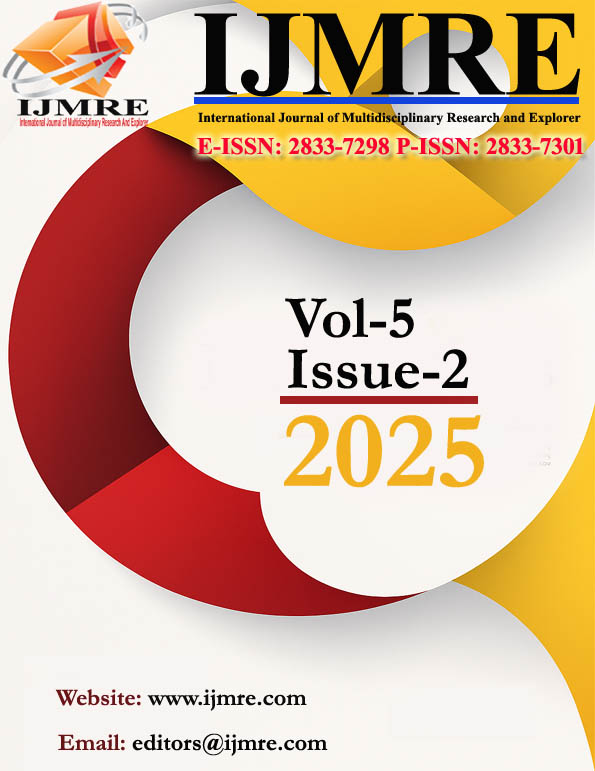A Fuzzy Logic-Based Decision Support System for Early Detection of COVID-19: A Review and Comparative Analysis
DOI:
https://doi.org/10.70454/IJMRE.2025.50201Keywords:
Fuzzy logic, artificial intelligence, medical decision-making, expert systems, COVID-19 diagnosisAbstract
The global COVID-19 pandemic, resulting from the infection by the SARS-CoV-2 virus, is emphasizing the urgent need for rapid and accurate diagnostic methods for the control of the infection spread. Lab-based testing methods can take time, leading to diagnostic delays and a high risk of transmission. Fuzzy Logic-Based Expert System in Early Detection of COVID-19 Symptoms and Risk Assessment in Real-Time. We provide a systematic review of published fuzzy logic models for the COVID-19 diagnosis along with details of their methodologies, accuracy, and clinical usability. Results support that fuzzy logic systems improve diagnostic efficiency, lessen healthcare pathways, and enable decision-making in a timely manner.
References
[1] Balanică, V., Dumitrache, I., Caramihai, M., Rae, W., & Herbst, C. (2011). Evaluation of breast cancer risk by using fuzzy logic. U.P.B. Science Bulletin, Series C, 73(1).
[2] Ejodamen, P. U., & Ekong, V. E. (2021). A fuzzy expert system model for the determination of coronavirus risk. International Journal of Mechatronics, Electrical and Computer Technology, 11(39), 4825–4831.
[3] Jadhav, B. T., & Nhivekar, G. S. (2021). Fuzzy expert system for severity measurement of COVID-19 suspects. International Journal of Research and Review, 8(12).
[4] Malathi, A., & Santra, A. K. (n.d.). Diagnosis of lung cancer disease using neuro-fuzzy logic. CARE Journal of Applied Research.
[5] Onuwa, O. B., et al. (2014). Fuzzy expert system for malaria diagnosis. International Open Free Access, Peer Reviewed Research Journal, 7(2), 273–284.
[6] Rao, S. G., Rao, M. E., & Prasad, D. S. (2013). Fever diagnosis rule-based expert systems. International Journal of Engineering Research & Technology, 2(8).
[7] Sharma, A. K. (2024). Time-Dependent Demand and Price Effects on Inventory Models: An Analytical Study. Asian Journal For Convergence In Technology (AJCT) ISSN -2350-1146, 10(3), 1-3. https://doi.org/10.33130/AJCT.2024v10i03.001
[8] Sharma, A. K., Adil, A. K., & Dubey, S. S. (2023). Overview of advancement of inventory models for deteriorating items with time based uniform price. International Journal of Innovative Research in Engineering, 4(1), 14–18.
[9] Sharma, A. K. (2022). The need for an inventory control system. IUP Journal of Operations Management, 21(1), 59-63.
[10] Sharma, A. K. (2015). Analysis of deteriorating inventory model for trapezoidal type demand rate. International Journal of Engineering Research & Management Technology, 2(6), 151–159.
[11] Sharma, A. K., & Bansal, K. K. (2016). Analysis of inventory model with time dependent demand under fractional backlogging. International Journal of Education and Science Research Review, 3(1), 103–111.
[12] Sharma, A. K. (2020). Inventory model for fixed deterioration within vending price order rate using limited backlogging. International Journal of Innovative Research in Technology, 6(9), 1–3.
[13] Sharma, A. K. (2022). Survey of development of inventory models with time-based uniform demand. In Innovation of multidisciplinary research in present and future time (pp. 76–81). Insta Publishing India.
[14] Sharma, A. K. (2019). An overview and study on inventory model with deteriorating items. International Journal of Scientific Research in Engineering and Management, 3(10), 1–5.
[15] Sharma, A. K. (2019). On some inventory model with deteriorating objects. International Journal for Scientific Research and Development, 7(8), 377–380.
[16] Sharma, A. K. (2019). An overview and study on inventory model with deteriorating items. International Journal of Scientific Research in Engineering and Management, 3(10), 1–8.
[17] Sharma, A. K. (2019). Study to overview on inventory management and related models. International Journal of Multidisciplinary Educational Research, 8(11)(2), 77–86.
[18] Sharma, A. K. (2015). Analysis of deteriorating inventory model for trapezoidal type demand rate. International Journal of Engineering Research & Management Technology, 2(6), 151–159.
[19] Sharma, A. K., & Bansal, K. K. (2016). Analysis of inventory model with time-dependent demand under fractional backlogging. International Journal of Education and Science Research Review, 3(1), 103–111.
[20] Saritas, I., Allahverdi, N., & Sert, I. U. (2003). A fuzzy expert system design for diagnosis of prostate cancer. International Conference on Computer Systems and Technologies – CompSysTech.
[21] Sharma, A. K. (2019). Overview of some applications of fuzzy generated systems. International Journal of Innovative Research in Technology, 6(6), 12–15.
[22] Sharma, A. K. (2020a). A brief overview of fuzzy logic theory. International Journal of Multidisciplinary Educational Research, 9(2-2), 74–84.
[23] Sharma, A. K. (2020b). The applicability of concepts of fuzzy set theory. International Journal of Research in Engineering, Science and Management, 3(1), 201–206.
[24] Sharma, A. K., & Padamwar, B. V. (2013). Fuzzy logic-based systems in management and business applications. International Journal of Innovative Research in Engineering & Science, 1(2), 1–6.
[25] Shatnawi, M., AlShara, Z., & Husari, G. (2021). Symptoms-based fuzzy-logic approach for COVID-19 diagnosis. International Journal of Advanced Computer Science and Applications, 12(4).
[26] Sharma, A. K. (2013). Fuzzy logic for utilization in intelligence cycle and in generation of alternatives. Abhinav Journal of Research in Science & Technology, 2(1), 1-4.
[27] Sharma, A. K., & Padamwar, B. V. (2013). Fuzzy logic based systems in management and business applications. International Journal of Innovative Research in Engineering & Science, 1(2), 1-6.
[28] Sharma, A. K. (2023). Study and overview of fuzzy numbers. In Recent innovative trends in interdisciplinary research areas (Vol. 1, pp. 42-46). https://doi.org/10.5281/zenodo.7696067
[29] Sharma, A. K. (2023). Overview of super-compactness on topological spaces. In Recent innovative trends in interdisciplinary research areas (Vol. 1, pp. 31-35). https://doi.org/10.5281/zenodo.7696026
Downloads
Published
Issue
Section
License
Copyright (c) 2025 Nidhi Mishra (Author)

This work is licensed under a Creative Commons Attribution 4.0 International License.
This is an Open Access article distributed under the term's of the Creative Common Attribution 4.0 International License permitting all use, distribution, and reproduction in any medium, provided the work is properly cited.







